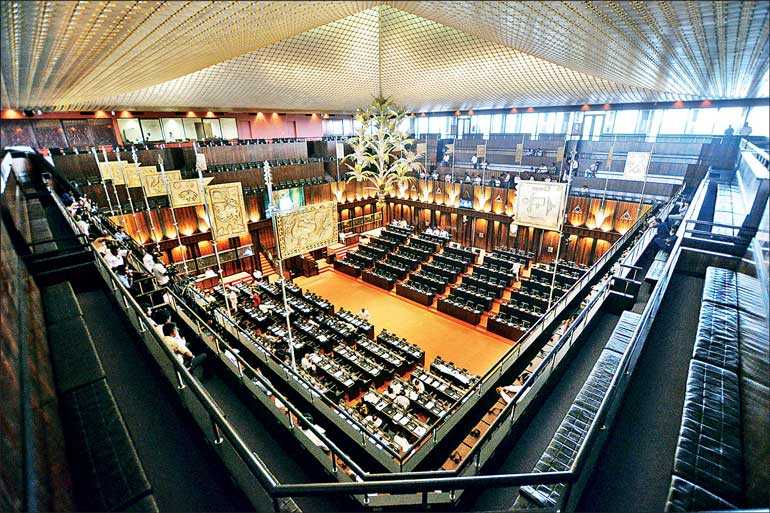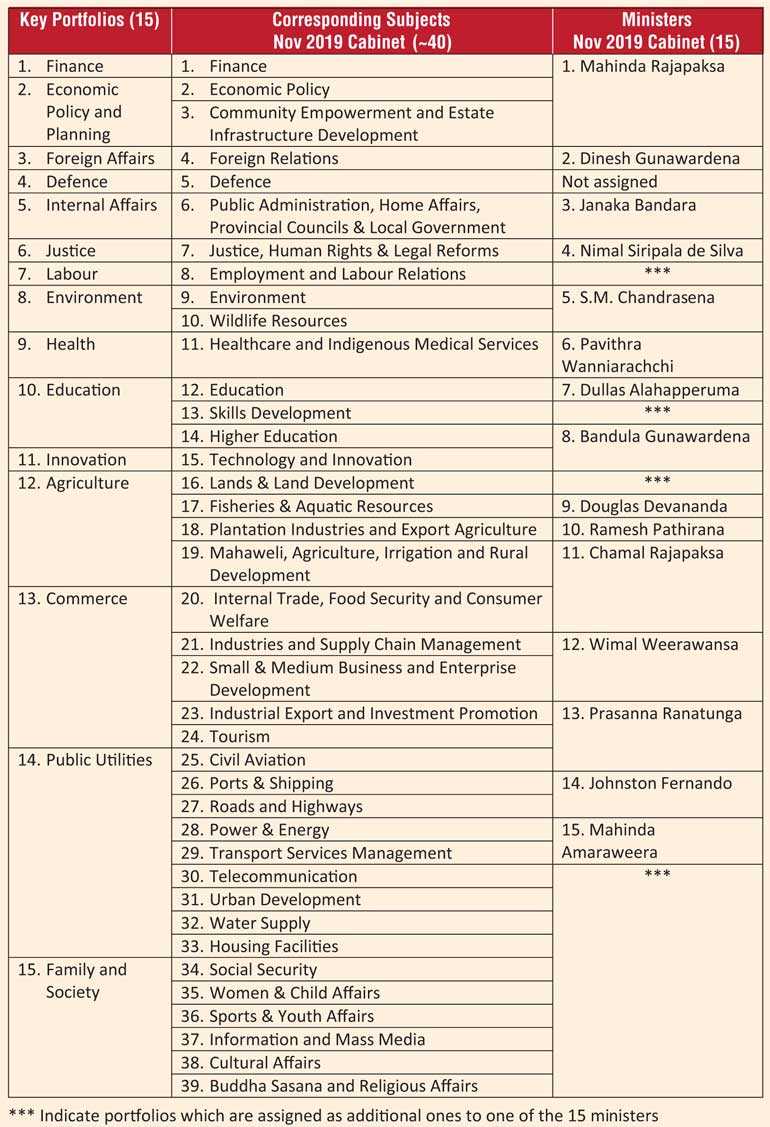Saturday Dec 13, 2025
Saturday Dec 13, 2025
Thursday, 6 August 2020 00:00 - - {{hitsCtrl.values.hits}}

The new normal is a term that captures life under the shadow of COVID-19 and/or the economic and social upheaval to follow. It is going be an extremely difficult time ahead for all concerned. In this scenario, the usual practice of distributing ministerial portfolios like candy will be
irresponsible. A lean and performance-driven Cabinet that is designed around post-COVID concerns is an imperative – Pic by Shehan Gunasekara

Sri Lanka is due to meet a massive debt obligation of $ 4 billion by October 2020. Ordinary people too are struggling with their own debt obligations after COVID-19 induced loss of livelihoods. Widespread hunger is a real possibility. 
The new normal is a term that captures life under the shadow of COVID-19 and/or the economic and social upheaval to follow. It is going be an extremely difficult time ahead for all concerned. In this scenario, the usual practice of distributing ministerial portfolios like candy will be irresponsible. A lean and performance-driven Cabinet that is designed around post-COVID concerns is an imperative.
The main concern in the post-COVID is the loss of livelihoods for workers and the dire consequences for their families. As the speakers representing the four political parties noted at a webinar hosted by Advocata on ‘The Economy after the Elections,’ the only way out is to create new businesses that can succeed in the new normal.
What new businesses will get us out of our economic woes? The Government or any one entity cannot possibly know the answer. Answers must come from those with skin the game already, or those who are enterprising enough to enter the fray. A government can only pave the way. Therefore, the imperative for the Government at this point is twofold – first alleviate suffering of those who are most vulnerable, and, secondly, remove obstacles for entrepreneurs who can recreate enterprises and take us out of the present economic morass.
In the past, every time a new government is to be formed, we come up with our ideal list of Cabinet portfolios to find ourselves soundly ignored. Learning from past experiences, I think we need to focus on outcomes, and challenge the Government to meet those with whatever structure they choose. At the end of the day, we should care about performance and accountability, not inputs or processes.
Splitting and combining of portfolios
The interim Cabinet formed by President Gotabaya Rajapaksa soon after the November 2019 election provides good material for the discussion. Although the Constitution allows for a 30-member Cabinet, in the November 2019 Cabinet, 29 portfolios consisting of nearly 40 distinct subjects were distributed among 15 ministers, with one minister holding more than one portfolio (see table).
Vertie Research recently developed a set of 15 key portfolios, using regional and global good practices as a guide. I use the same set with minor modifications (column one in the table) to analyse the Cabinet formed after November 2019. Only the first nine key portfolios out of the 15 key portfolios have a single minister responsible for each. Other six portfolios are split among two to five ministers for each.
In forming a new Cabinet, the President will have to consider the optimum way of combining these subjects, keeping in mind, the 100+ departments, 300+ statutory bodies and more than 1000 entities in total if you take into account state enterprises, their subsidiaries and sub-subsidiaries, and instruments of decentralisation such district secretariats and divisional secretariats.
Let us look at 15 categories in somewhat detail to understand some of the issues.
Traditional standalone portfolios (9)
These include Finance, Economy, Foreign Affairs, Defence, Home Affairs, Justice, Labour, Environment and Health portfolios which typically have remained intact over the years and have their own office premises, long established or newly established.
With the exception of the Economy portfolio, other eight portfolios exist as stand-alone portfolios in cabinets in in US, UK and Australia as well as in Cabinets in 10 other countries in Asia that we checked – i.e. Bangladesh, India, Indonesia, Malaysia , Nepal, Singapore, South Korea, Taiwan, Thailand, and Vietnam. Economic Policy and Planning finds different forms in different countries, but usually vested with the Prime Minister.
Education
Sri Lanka is unique in having the subject of education split into several ministries. The 2001 Cabinet was the only occasion when education was represented by a single minister in the Cabinet, but the subjects were kept very much separate as School Education and Tertiary Education with two State ministers assigned for the purpose. Since then education has been split three-ways as School Education, Technical Education and Vocational Training (TVET) and Higher Education.
The Yahapalana Government added insult to injury to the subject of higher education when they first pared it with Highways and then with Water. TVET is the stepchild seemingly tossed around to whoever at the last minute. The President has inquired whether it is possible to have one ministry for education. Very good news indeed for education in Sri Lanka.
Innovation
Ministries dedicated to one or more of the subjects – Innovation, Science, Technology or Research – are in almost all the countries we checked. In the 2019 November Cabinet of Sri Lanka, the subject is bundled with Higher Education.
Verité Research too bundles innovation with education. This bundling does not take into account the reality that higher education in Sri Lanka is merely an exercise in increasing places for all who ‘qualify’. I believe that innovation deserves a special ministry and entrusted with the task of coordinating all research institutions in the country, including research and post-graduate education in universities in Sri Lanka with the goal of a world-class cluster of research and innovation.
Agriculture
Verité Research has detailed the harms of the splitting of portfolios, specially the agriculture portfolio. In the 2019 November Cabinet, the Agriculture portfolio was divided into five subject areas and assigned to four different ministers.
Whichever the way the new Government chooses to split the agriculture portfolio, a post COVID imperative would be to revive agricultural enterprises, micro, small, medium or large, restore livelihoods and increase exports.
Lands and Land Development is an interesting case in that regard. In the 2019 Cabinet, the portfolio was given to S.M. Chandrasena who was also the Minister for Environment and Wildlife, implying protection of land as a key driver. On the other hand, land is a necessity of any enterprise, agricultural, industry or even services.
A study by the previous Government with the support of the Millennium Challenge Corporation (MCC) identified land and transport issues as major obstacles to growth. Whether the Lands portfolio should be closely aligned with Ministry of Economic Development and Planning is an interesting question for further consideration.
Commerce
The subject of commerce was split into five portfolios divided among three ministers in the November 2019 Cabinet – i.e. Industrial Export and Investment Promotion and Tourism; Industries and Supply Chain Management and Small and Medium Business and Enterprise Development; and Internal Trade, Food Security and Consumer Welfare.
At the end of the day, here too, the Government has the responsibility to revive the industries whether they are into trade, production or services; export oriented or internal; or micro, small, medium or large. The Government should be judged by that measure, not the inputs.
Public utilities
While the subjects of Ports, Shipping, Aviation, Roads, Transport, Telecommunication and Water seem so diverse, they all concern building, maintenance and regulation of large-scale infrastructures. Typically, a government bureaucracy needs to enter into contracts with enterprises, state-owned or private, to build and operate these.
The Public Utilities Commission is already set up to expand its role and handle regulation of these sectors. Issues around the transparency of these contracts and regulation of the operations are similar. Whether the ownership and operation of these utilities is by the Government or partnerships is a political issue common to all. It remains to be seen whether these portfolios will be viewed in this light and brought together to the extent possible.
Family and society
It is difficult to determine where family issues end and society begins, but the trend globally is to cluster all such subjects under one ministry. For example, see Ministries for Social and Family Development (Singapore), Social Welfare (Bangladesh), Women, Family and Community Development (Malaysia) and Social Affairs (Indonesia).
From among the subjects covered in the 2019 November Cabinet, the portfolios that can be put into this category include Social Security, Women and Child Affairs, Sports and Youth Affairs, Information and Mass Media, Cultural Affairs, Buddha Sasana and Religious Affairs. Interesting to see if the government would take a broad of view family and social issues or the subject under this key portfolio will be used as fillers or sweeteners in the new Cabinet.
While Social Security will be a critically important in the present environment, the need for an Information and Mass Media portfolio should be questioned. Sri Lanka is unique among the Cabinets in US, UK, Australia and 10 other countries in Asia in having an Information and Mass Media portfolio.
The UK has a Department for Digital, Culture, Media and Sport (DCMS) whose mission is to “protect and promote [their] cultural and artistic heritage and help businesses and communities to grow by investing in innovation and highlighting Britain as a fantastic place to visit”. In Sri Lanka the Mass Media Ministry is used as an instrument to control the media.
Key Performance Indicators
When I served as Director General of the Tertiary and Vocational Education Commission (or TVEC), one of my first duties was to meet with Karu Jayasuriya, who was the Chairman of COPE at that time, I believe. TVEC had submitted performance target the year before and I was answerable to reports that were unfinished and so on.
I was pleasantly surprised to see some of the concepts I learned in the US in my public policy and management studies being put into practice at the agency level in our little corner of the world. I don’t think they practice the same level of earnestness after Karu Jayasuriya.
The 2015 Budget introduced Key Performance Indicators for the first time at the ministry level. These too do not seem to be taken too seriously by the ministries.
While each government would want to set its own set of policy priorities and Key Performance Indicators, civil society organisation would do well to develop their own KPIs which are common to the sector of interest to them. For example, the Education Forum Sri Lanka of which I am co-coordinator plans on developing KPIs for the education.
Accountability
The ultimate body for accountability is the Parliament which must approve all expenditures by the Executive. There were 14 sectoral committees in the previous Parliament. These committees closely parallel the 15 ‘logical’ portfolios identified here. Past reports from these committees show them to be lost in detail, but these committees can be made more useful if civil society takes an interest and engages with them.
(The writer is a scientist turned policy analyst specialising in education and public sector performance issues. She can be reached at [email protected] or [email protected].)